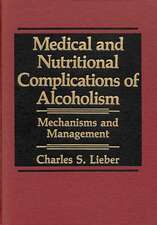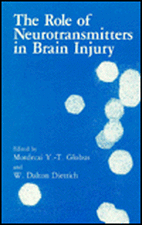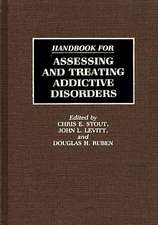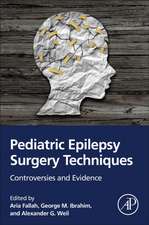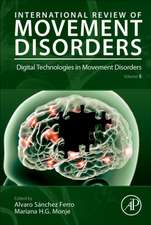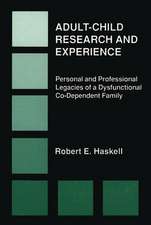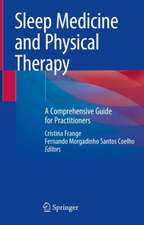Movement Disorders: 100 Instructive Cases
Editat de Stephen G. Reichen Limba Engleză Hardback – 21 noi 2008
A bonus website link includes video-clips of each patient. The captions and key points provided enable the busy neurologist to quickly reference information needed in day-to-day practice.
Preț: 1430.43 lei
Preț vechi: 1505.71 lei
-5% Nou
Puncte Express: 2146
Preț estimativ în valută:
273.70€ • 285.80$ • 226.02£
273.70€ • 285.80$ • 226.02£
Carte tipărită la comandă
Livrare economică 15-29 aprilie
Preluare comenzi: 021 569.72.76
Specificații
ISBN-13: 9781841845241
ISBN-10: 1841845248
Pagini: 448
Dimensiuni: 156 x 234 x 23 mm
Greutate: 0.93 kg
Ediția:1 HAR/CDR
Editura: CRC Press
Colecția CRC Press
Locul publicării:Boca Raton, United States
ISBN-10: 1841845248
Pagini: 448
Dimensiuni: 156 x 234 x 23 mm
Greutate: 0.93 kg
Ediția:1 HAR/CDR
Editura: CRC Press
Colecția CRC Press
Locul publicării:Boca Raton, United States
Public țintă
Professional and Professional ReferenceCuprins
1. Familial Dystonia, Parkinsonism, Ataxia, and Dementia: What Is It?. 2. Primary Dystonia: A Surgical Disease?. 3. A Curable Form of Dystonia Not to Be Missed. 4. A Neurology Consultation for Parkinson's on the Psychiatry Service. 5. Facial Twitching: What Is It and How Do You Treat It?. 6. An Uncontrollable Arm. 7. A Woman Who Can Walk But Not Stand. 8. A Child with a Severe Movement Disorder on the Psychiatry Unit. 9. Progressive Slowing and Gait Disorder. 10. Three Faces of Essential Tremor. 11. New-Onset 'Tics' in a Patient Treated for Gilles de la Tourette's Syndrome. 12. How to Roll-Out the Work-Up When the Patient's Brain has 'Rocks'. 13. Parkinson's Disease, Pain, and Melanoma. 14. Ear Clicking after a Stroke. 15. Atypical Parkinsonism and Cerebellar Ataxia. 16. 'Off' Dystonia. 17. A Man with Parkinson's Catching a Few 'Z's'. 18. A 44-Year-Old Man with Dizziness since the Teens. 19. Weakness, Ataxia, and Myoclonus in a 68-Year-Old Woman. 20. Chorea and Action-Induced Myoclonus. 21. A Case of Seizures, Orofacial Dyskinesias, and Peripheral Neuropathy. 22. A Case of Intermittent Chorea Induced by Coffee. 23. A Curable Cause of Dystonia. 24. Severe Truncal Flexion in a Man with Parkinson's Disease. 25. Slowly Progressive Gait Disorder in a 45-Year-Old Woman. 26. When Both Motion and Mentation Fail. 27. Asymmetric Limb Rigidity and Apraxia. 28. PD, PDD, DLB, or AD?. 29. Bent Spine and Knees in Parkinson's Disease. 30. A Family with Progressive Atypical Parkinsonism, Dementia, and Neuropsychiatric Changes. 31. One Wrong Movement Leads to Another. 32. A Face to Remember... . 33. Destiny's Child. 34. Hidden in Plain View. 35. A Case of Hand Tremor Where Deep Brain Stimulation Failed. 36. Forgetful and Fidgety. 37. Too Much of a Good Thing. 38. Parkinsonism with Dysautonomia: MSA or PD?. 39. Levodopa Responsive Parkinsonism: Is It Parkinson's Disease?. 40. A Woman with Recurrent Ataxia and Facial Myoclonus. 41. Parkinson's Disease: After the Honeymoon. 42. An Unusual Hazard of Treating Depression. 43. Parkinson's Gait: When Falls Become Pitfalls. 44. A 70-Year-Old Man with Tremor, Ataxia, and Bright Middle Cerebellar Peduncles. 45.Tremor after Quarrel and Minor Head Trauma: Organic Cause or Psychologic Trigger?. 46. An 82-Year-Old Man with Flailing Movements of his Right Side after a Stroke. 47. An 11-Year-Old Boy with Jerky Movements and Impaired Gait. 48. A 32-Year-Old Woman with Lymphadenopathy, Arthritis, and Chorea. 49. A Tremor in Multiple Sclerosis. 50. Dopa Responsive Dystonia? Perhaps. But What Else Does She Have?. 51. An Infrequent Form of Focal Dystonia. 52. A 43-Year-Old Woman with Severe Involuntary Movements. 53. Is it PD, PSP, CBD, DLB, or MSA?. 54. Valvular Heart Disease in a Man with Parkinson's Disease. 55. Ataxia and Parkinsonism. 56. What Looks Like Corticobasal Degeneration but Is Not Corticobasal Degeneration?. 57. Rapidly Progressing Parkinsonism. 58. Clumsy Gait and Leg Pain. 59. A Woman with Progressive Ataxia and Hallucinations. 60. A Case of Rhythmic Abdominal Movements. 61. Parkinson Disease: What to Do When There Seems Nothing More to Do. 62. Is it PD or DLB? Timing is Everything. 63. Consult for a Neurohepatologist. 64. Tricking a Patient with Oromandibular Dystonia. 65. Focal Dystonia in a String Musician: Strumming the Wrong Tune. 66. An Intractable Movement Disorder Cured. 67. Internet Dyskinesias in Parkinson's Disease. 68. An Elderly Lady with Ataxia and Neuropathy. 69. Leg and Back Cramps: Psychogenic or Organic?. 70. Early-Onset Chorea Progressing to an Ataxic Syndrome. 71. Hemisensory Syndrome with an 'Upgoing Toe'. 72. Rapid-Onset Dystonia-Parkinson in a Brother and Sister. 73. A Young Man with Psychosis, Ataxia, And Signal Changes in the Splenium. 74. An Unusual Jaw Tremor. 75. What Looks like Huntington's Disease but Isn't?. 76. SCA Patient with Tremor Preceding Ataxia. 77. Painful Involuntary Neck Movements in a 45-Year-Old Woman. 78. A Stimulating Treatment for Essential Tremor. 79. The Coat Hanger Sign. 80. Lewy Body Parkinson's Disease in a Familial Case: What Is Idiopathic Parkinson's Disease?. 81. A Cerebellar Syndrome without Cerebellar Signs. 82. Facial Twitches in an Elderly Man. 83. A Man with Quick Jerks, Inappropriate Vocalizations, Chronic Anxiety, and Compulsions. 84. A Young Man with a Jerky Hand. 85. An Unusual Cause of Stuttering. 86. The Case of the Freezing Man. 87. A Stridorous Woman. 88. Ataxia in a son and mother. 89. 'Here Comes the Judge' (with Absent Left Arm Swing). 90. Changing Tremor in a 45-Year-Old Woman. 91. Is Tremor Essential?. 92. Low Cholesterol Can Be Bad For Your Health. 93. A Man with a jerky, Useless Arm. 94. Chorea in a Septuagenarian. 95. Treatment of Dyskinesias in Parkinson's Disease: New Use of an Old Drug. 96. Asymmetrical Movement Disorder and Behavioral Disturbance in a Young Man. 97. A Rock Solid Case of Parkinsonism. 98. A Fragile Diagnosis. 99. Patient Selection for Deep Brain Stimulation for Idiopathic Parkinson's Disease. 100. Two Guitarists with 'Dys-tune-ia'
Notă biografică
Stephen G. Reich, Professor of Neurology The Clair Zamoiski Segal and Thomas H Segal Professor of Parkinson’s Disease Co-Director The Maryland Parkinson’s Disease and Movement Disorders Center The University of Maryland School of Medicine Baltimore, MD USA.
Descriere
Written in an easy-to-follow quick reference format, This highly useful text provides a series of 100 patient case studies need to care for patients with movement disorders. Radiology images, histopathology, and patient photographs are presented in full color. Each disorder will follow the flowing quick reference format:history examination discussion teaching points A bonus website link includes video-clips of each patient, in a high quality video rendering format, that examine their corresponding movement disorder. Organized numerically to coincide with the books easy-to-follow format, the website also includes captions and key talking points added to the video clips that enable the busy neurologist to reference information even faster.




